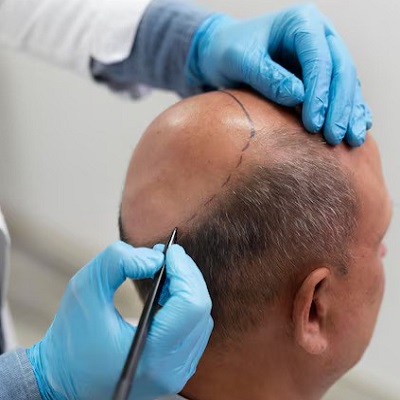
Hair loss is a common issue that affects millions of people worldwide, and it can have a significant impact on self-esteem and confidence. Thankfully, advancements in medical technology have made hair transplants a viable and effective solution for those seeking to restore their hair. In this blog, we’ll explore everything you need to know about hair transplants, including how the procedure works, the different types of transplants, and what to expect before, during, and after the treatment.
What is a Hair Transplant?
A hair transplant is a surgical procedure that involves relocating hair follicles from one part of the scalp (typically the back or sides) to areas experiencing thinning or baldness. The goal is to restore a fuller, more natural hairline or crown. This procedure is typically done under local anesthesia, ensuring the patient feels no pain during the surgery.
Hair transplant surgery can be used for various types of hair loss, including male and female pattern baldness, receding hairlines, and even hair loss due to trauma or burns.
How Does a Hair Transplant Work?
Hair transplants primarily involve two methods: FUE (Follicular Unit Extraction) and FUT (Follicular Unit Transplantation). Both techniques involve extracting hair follicles from a donor site and implanting them into a recipient area.
FUE (Follicular Unit Extraction)
FUE is the most popular and advanced technique of hair transplant. In this method, individual hair follicles are removed from the donor site one by one using a small, circular punch. The extracted follicles are then carefully implanted into the thinning or balding areas. The main advantage of FUE is that it doesn’t leave a large scar, as the extraction is done without the need for incisions.
FUT (Follicular Unit Transplantation)
In the FUT method, a strip of skin from the donor area is removed, and the hair follicles are dissected and transplanted into the balding area. This technique typically results in a linear scar in the donor area, but it is still a highly effective method for larger areas of hair loss.
What to Expect Before the Procedure:
Before undergoing a hair transplant, you will typically have a consultation with a skilled surgeon. During this consultation, your medical history, hair loss patterns, and expectations will be discussed. Your doctor will also examine your scalp and determine the best approach for your specific needs.
If you’re a candidate for the procedure, the doctor will discuss any necessary pre-operative care, such as avoiding certain medications or stopping smoking. It’s crucial to follow these instructions carefully to ensure optimal results.
The Procedure: What Happens During Surgery?
On the day of the procedure, you’ll arrive at the clinic, and local anesthesia will be administered to the donor and recipient areas. The surgery can take anywhere from 4 to 8 hours, depending on the extent of the transplant and the method chosen.
Once the anesthesia has taken effect, the surgeon will begin the extraction process. Afterward, tiny incisions will be made in the recipient area to insert the hair follicles. The entire procedure is performed with great care to ensure that the new hair follicles match the natural growth pattern of the surrounding hair.
Aftercare and Recovery:
Recovery after a hair transplant is generally quick, though it’s essential to follow your doctor’s aftercare instructions. For the first few days, you may experience mild swelling, redness, and some scabbing around the transplanted follicles. These symptoms typically subside within a week.
Patients are advised to avoid strenuous physical activities, excessive sun exposure, and touching or scratching the scalp during the initial recovery period. Most people return to work within 3-5 days after the procedure, though it may take a few weeks for the transplanted hair to fully settle in.
Results: When Will You See Hair Growth?
Hair transplant results vary depending on the individual. Typically, the transplanted hair will fall out within the first few weeks following the procedure. This is a normal part of the process, as the follicles enter a resting phase. New hair growth usually begins around 3 to 4 months after the transplant, with the final results visible between 9 to 12 months post-surgery.
It's important to remember that hair transplants are permanent, as the follicles are taken from areas that are genetically resistant to hair loss. However, additional procedures may be needed over time to maintain optimal results, especially if you continue to experience hair loss in other areas of the scalp.
Risks and Considerations:
While hair transplants are generally safe, like any surgery, there are some risks involved. These may include infection, scarring, and an unnatural appearance if the procedure is not performed correctly. That’s why choosing a qualified and experienced surgeon is crucial to ensuring the best outcome.
Additionally, while hair transplants can restore lost hair, they don’t prevent further hair loss. Ongoing treatments, such as medications like minoxidil or finasteride, may be recommended to maintain and enhance your results.
Conclusion:
Hair transplants offer a lasting and effective solution for those struggling with hair loss. With advancements in techniques like FUE and FUT, patients can achieve natural-looking results with minimal scarring and downtime. If you're considering a hair transplant, it's important to consult with a skilled surgeon to understand your options and ensure you have realistic expectations.
Ultimately, a hair transplant can be life-changing, helping you regain your confidence and feel better about your appearance. If you're ready to take the next step toward a fuller head of hair, research your options, and seek out a trusted medical professional to guide you through the process.
For more information visit Dynamic Clinic PK.











